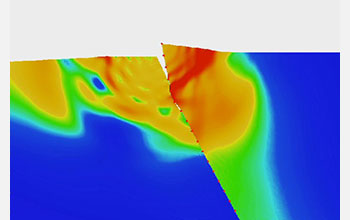Multimedia Gallery
Earthquakes can open and shut thrust faults
Engineers and scientists have experimentally observed surface twisting in thrust faults that can momentarily rip open the Earth's surface. Here, an illustration based on a computer model shows how the hanging wall (right) of a thrust fault is twisting away from the foot wall (left) during an earthquake.
More about this image
New experimental research shows how the Earth can split open -- and then quickly close back up -- during earthquakes along thrust faults, a theory that earthquake scientists have long held does not happen.
Thrust faults, which occur in weak areas of the Earth's crust, where one slab of rock compresses against another, sliding up and over it during an earthquake, have been the site of some of the world's largest quakes, such as the 2011 Tohoku earthquake off the coast of Japan, which damaged the Fukushima nuclear power plant.
A team of engineers and scientists from the California Institute of Technology (Caltech) and École normale supérieure (ENS) in Paris has discovered that fast ruptures propagating up toward the Earth's surface along a thrust fault can cause one side of a fault to twist away from the other, opening up a gap of up to a few meters that then snaps shut.
Thrust fault earthquakes usually happen when two slabs of rock press against one another and the pressure overcomes the friction holding them in place. The assumption has been that at shallow depths, the plates would slide against one another for a short distance, without opening. But in studying the Tohoku earthquake, researchers found that not only did the fault slip at shallow depths, it did so by as much as 50 meters in some places. That huge motion, which occurred just offshore, triggered a tsunami that caused damage to facilities along the coast of Japan including at the Fukushima Daiichi Nuclear Power Plant.
This research was supported by the National Science Foundation (NSF) (grant EAR 13-21655).
Learn more about this research in the NSF News From the Field story Earthquakes can make thrust faults open violently and snap shut. (Date image taken: 2016; date originally posted to NSF Multimedia Gallery: May 30, 2018)
Credit: Harsha S. Bhat, ENS
Images and other media in the National Science Foundation Multimedia Gallery are available for use in print and electronic material by NSF employees, members of the media, university staff, teachers and the general public. All media in the gallery are intended for personal, educational and nonprofit/non-commercial use only.
Images credited to the National Science Foundation, a federal agency, are in the public domain. The images were created by employees of the United States Government as part of their official duties or prepared by contractors as "works for hire" for NSF. You may freely use NSF-credited images and, at your discretion, credit NSF with a "Courtesy: National Science Foundation" notation.
Additional information about general usage can be found in Conditions.
Also Available:
Download the high-resolution JPG version of the image. (96.4 KB)
Use your mouse to right-click (Mac users may need to Ctrl-click) the link above and choose the option that will save the file or target to your computer.



